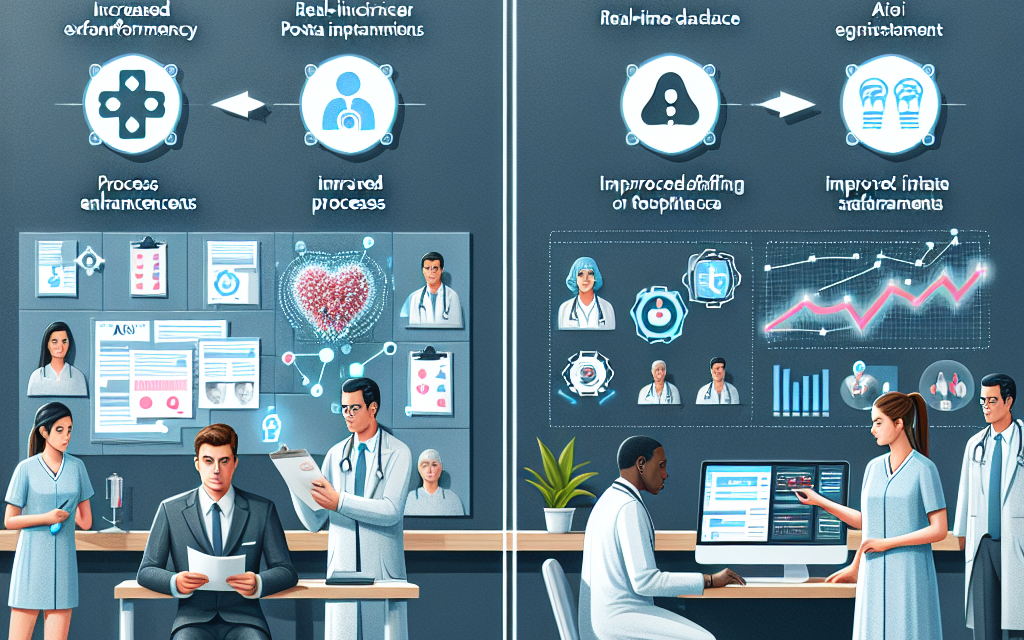Transforming Patient Experience: The ROI of AI-Driven Process Enhancements
The healthcare industry is undergoing a significant transformation, driven by advancements in technology and the increasing demand for improved patient experiences. Artificial Intelligence (AI) has emerged as a powerful tool that can enhance various processes within healthcare settings, leading to better patient outcomes, increased efficiency, and ultimately, a higher return on investment (ROI). This article explores the multifaceted impact of AI-driven process enhancements on patient experience, focusing on five key areas: personalized care, operational efficiency, predictive analytics, telehealth innovations, and patient engagement. Each section will delve into the benefits, challenges, and real-world applications of AI in these domains.
1. Personalized Care: Tailoring Treatments to Individual Needs
Personalized care is at the forefront of modern healthcare, emphasizing the need to tailor treatments and services to individual patient needs. AI plays a crucial role in this transformation by analyzing vast amounts of data to provide insights that can lead to more effective and personalized treatment plans.
AI algorithms can process data from various sources, including electronic health records (EHRs), genetic information, and patient-reported outcomes. By leveraging machine learning, healthcare providers can identify patterns and correlations that may not be immediately apparent. For instance, AI can help in identifying which patients are at higher risk for certain conditions based on their genetic makeup and lifestyle factors.
- Case Study: IBM Watson for Oncology – IBM Watson has been utilized in various hospitals to assist oncologists in developing personalized treatment plans for cancer patients. By analyzing patient data and the latest research, Watson can recommend treatment options tailored to the individual’s specific cancer type and genetic profile.
- Example: Genomic Medicine – AI-driven genomic analysis allows for the identification of mutations that may influence treatment decisions. For example, patients with specific mutations may respond better to targeted therapies, leading to improved outcomes.
Moreover, AI can enhance the patient experience by providing personalized recommendations for lifestyle changes, medication adherence, and follow-up care. Chatbots and virtual health assistants can engage with patients, offering tailored advice based on their health data and preferences.
However, the implementation of personalized care through AI is not without challenges. Issues such as data privacy, the need for robust data infrastructure, and the potential for algorithmic bias must be addressed to ensure equitable access to personalized treatments.
2. Operational Efficiency: Streamlining Healthcare Processes
Operational efficiency is critical in healthcare, where resource constraints and high demand often lead to bottlenecks in service delivery. AI-driven process enhancements can significantly streamline operations, reducing wait times and improving overall patient satisfaction.
AI technologies can automate routine administrative tasks, such as appointment scheduling, billing, and claims processing. By reducing the administrative burden on healthcare staff, organizations can allocate more time to patient care. For example, AI-powered chatbots can handle appointment bookings and answer common patient inquiries, freeing up staff to focus on more complex tasks.
- Case Study: Mount Sinai Health System – Mount Sinai implemented an AI-driven scheduling system that optimizes appointment slots based on patient needs and provider availability. This system has led to a significant reduction in no-show rates and improved patient flow.
- Example: Revenue Cycle Management – AI can enhance revenue cycle management by predicting claim denials and automating follow-up processes. This not only improves cash flow but also reduces the administrative workload on billing departments.
Additionally, AI can assist in inventory management by predicting supply needs based on patient volume and historical data. This proactive approach minimizes waste and ensures that essential supplies are always available, contributing to a smoother operational flow.
Despite these advantages, healthcare organizations must invest in training staff to work alongside AI systems and ensure that the technology is integrated seamlessly into existing workflows. Resistance to change and the fear of job displacement can hinder the successful adoption of AI-driven operational enhancements.
3. Predictive Analytics: Anticipating Patient Needs
Predictive analytics is a powerful application of AI that enables healthcare providers to anticipate patient needs and improve outcomes. By analyzing historical data, AI can identify trends and predict future events, allowing for proactive interventions.
For instance, predictive analytics can be used to identify patients at risk of hospital readmission. By analyzing factors such as previous admissions, comorbidities, and social determinants of health, AI algorithms can flag high-risk patients for targeted follow-up care. This proactive approach not only improves patient outcomes but also reduces healthcare costs associated with readmissions.
- Case Study: Geisinger Health System – Geisinger implemented a predictive analytics program that identifies patients at risk for complications after surgery. By providing additional support and resources to these patients, the health system has significantly reduced readmission rates.
- Example: Chronic Disease Management – AI can help manage chronic diseases by predicting exacerbations and enabling timely interventions. For example, patients with diabetes can receive alerts when their blood sugar levels are trending dangerously high or low.
Moreover, predictive analytics can enhance population health management by identifying trends within specific demographics. This information can guide public health initiatives and resource allocation, ultimately leading to better health outcomes for entire communities.
However, the effectiveness of predictive analytics relies heavily on the quality and completeness of the data used. Healthcare organizations must invest in data governance and ensure that they have access to comprehensive datasets to maximize the benefits of predictive analytics.
4. Telehealth Innovations: Expanding Access to Care
Telehealth has gained significant traction in recent years, particularly in the wake of the COVID-19 pandemic. AI-driven innovations in telehealth are transforming how patients access care, making it more convenient and efficient.
AI can enhance telehealth services by providing virtual triage, symptom checkers, and remote monitoring tools. For example, AI-powered chatbots can assess patient symptoms and recommend appropriate next steps, whether that be scheduling a telehealth appointment or directing them to urgent care.
- Case Study: Babylon Health – Babylon Health utilizes AI to provide virtual consultations and health assessments. Patients can interact with an AI chatbot that evaluates their symptoms and offers personalized health advice, significantly reducing the need for in-person visits.
- Example: Remote Patient Monitoring – AI can analyze data from wearable devices to monitor patients’ health in real-time. This capability is particularly beneficial for managing chronic conditions, as it allows for timely interventions when abnormalities are detected.
Telehealth also expands access to care for underserved populations, including those in rural areas or with mobility challenges. By leveraging AI, healthcare providers can offer high-quality care remotely, reducing barriers to access and improving patient satisfaction.
Despite the benefits, challenges such as technology adoption, reimbursement policies, and regulatory hurdles must be addressed to fully realize the potential of AI-driven telehealth innovations. Ensuring that patients have access to the necessary technology and internet connectivity is also crucial for equitable access to telehealth services.
5. Patient Engagement: Empowering Patients in Their Care Journey
Patient engagement is a critical component of improving the overall patient experience. AI-driven tools can empower patients by providing them with the information and resources they need to take an active role in their healthcare.
AI can facilitate personalized communication through patient portals, mobile apps, and chatbots. These tools can provide patients with tailored health information, medication reminders, and educational resources based on their specific conditions and treatment plans.
- Case Study: MyChart by Epic Systems – MyChart is a patient portal that allows patients to access their health information, communicate with providers, and manage appointments. AI-driven features within the portal can provide personalized health tips and reminders, enhancing patient engagement.
- Example: Gamification of Health – Some healthcare organizations are using gamification techniques to encourage patients to engage with their health. AI can track progress and provide rewards for achieving health goals, making the process more enjoyable and motivating.
Furthermore, AI can analyze patient feedback and sentiment to identify areas for improvement in the patient experience. By understanding patient preferences and concerns, healthcare organizations can make data-driven decisions to enhance services and address issues proactively.
However, fostering patient engagement through AI requires a thoughtful approach to ensure that patients feel comfortable using technology. Healthcare providers must prioritize user-friendly interfaces and provide support to help patients navigate digital tools effectively.
Conclusion: The Future of Patient Experience with AI
The integration of AI-driven process enhancements in healthcare has the potential to transform patient experiences significantly. From personalized care and operational efficiency to predictive analytics, telehealth innovations, and patient engagement, AI offers a multitude of benefits that can lead to improved outcomes and higher ROI for healthcare organizations.
As the healthcare landscape continues to evolve, it is essential for organizations to embrace AI technologies while addressing the challenges that come with them. By investing in data quality, staff training, and patient education, healthcare providers can harness the full potential of AI to create a more efficient, effective, and patient-centered healthcare system.
In summary, the ROI of AI-driven process enhancements is not just measured in financial terms but also in the quality of care provided to patients. By prioritizing patient experience through innovative technologies, healthcare organizations can build a more sustainable and responsive system that meets the needs of patients today and in the future.





